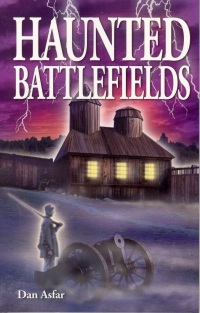| ________________
CM . . .
. Volume XI Number 11 . . . .February 4, 2005
excerpt: If the War of 1812 is the great forgotten war, then Chippewa is its invisible battlefield. Matthew Didier boils this down to Canadian nationalism. "The interesting thing about Chippewa," Matthew says, "is because it wasn't a Canadian victory, it wasn't really celebrated and was a farmer's field for basically 200 years." It's easy to see why the nation would prefer to forget Chippewa, given the rather embarrassing details of the battle. (Pg 194.) What kind of tips was Didier's group going to check out? "There were two different sources'" Didier says today. "One of them was a group of guys that were out there one night, around dusk, firing off .22s. The battlefield wasn't marked back then, but they described the area to us, the location, and we were able to confirm that it was Chippewa." Whatever shenanigans these kids were up to, they came to an abrupt end when the sounds of carnage became audible - carnage that was impossible with just a couple of loaded .22s. "They heard a battle being fought around them," Didier says...... While one such report might not necessarily merit an investigation, two certainly would, and Didier's organization received another call about Chippewa not long after the first..... (Pg 195.) Dan Asfar has collected 19 stories about battlefields where he is referring to a "vague impression that defies any attempt at concrete definition - a sense that sits somewhere between fascination and unease, curiosity and revulsion." His stories are all based on "well established folktales or else written by eye-witness accounts - all purportedly true." So glowing blue orbs and phantom drumbeats, spirits and supernatural remnants are purported to be seen at well known battlefields. Some come from the American Civil War, such as Antietam and Gettysburg, but other scenes are included, such as the Battle of Mons in Belgium, during World War I, a General Wayne Inn used by soldiers from both sides during the American War of Independence, Hat Creek of 1876, the Battle of the Little Bighorn, the Battle of the Headless Frenchman from the French and Indian Wars, and the War of 1812. The author provides appropriate history for each of the battles, including personalities involved, the terrain, political background and the strategies for the battle. For history buffs, these accounts will add to their understanding of battles in American history and for those looking for sightings of phantoms, there is plenty of material to be crafted into a good story. Black and white photos of individuals, landscapes and buildings provide additional information for the readers. The stories are between 10 and 20 pages long and have a fluid writing style that could be used by English teachers as examples of good writing techniques. A table of contents lists battles by name but does not include any more information, and there is no index. In the acknowledgments, various sources are mentioned by author and title only. The subjects, ghosts and battles, always have their readership, and this book is recommended for any collection in junior/senior high or public libraries. Recommended. Meredith MacKeen is a teacher-librarian at Glen Stewart School in Stratford, PE.
To comment
on this title or this review, send mail to cm@umanitoba.ca.
Copyright © the Manitoba Library Association. Reproduction for personal
use is permitted only if this copyright notice is maintained. Any
other reproduction is prohibited without permission.
NEXT REVIEW |
TABLE OF CONTENTS FOR THIS ISSUE
- February 4, 2005.
AUTHORS |
TITLES |
MEDIA REVIEWS |
PROFILES |
BACK ISSUES |
SEARCH |
CMARCHIVE |
HOME |
